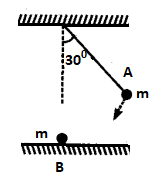
The bob ${{A}}$ of a pendulum released from $30^\circ$ to the vertical hits another bob ${{B}}$ of the same mass at rest on a table as shown in fig. How high does the bob ${{A}}$ rise after the collision? Neglect the size of the bobs and assume the collision to be elastic.

Answer
218.1k+ views
Hint: According to the conservation of momentum, the momentum of a system is constant when no external forces are acting on the system. Here momentum will be transferred from bob ${{A}}$ to bob ${{B}}$ which satisfies the conservation of momentum. When momentum is being transferred then bob ${{A}}$ will come to rest and it will not rise anymore after the collision.
Complete step by step solution:
Given: Masses of bob ${{A}}$ and bob ${{B}}$ are equal
Bob ${{A}}$ of a pendulum released from ${{3}}{{{0}}^{{0}}}$ to the vertical
Bob ${{A}}$ hits bob ${{B}}$ where bob ${{B}}$ is at rest
Let us assume that the collision is elastic. In an elastic collision, two equal masses where one is stationary and the other is moving with some velocity, the stationary mass acquires the same velocity. However, the moving mass comes to rest immediately after the collision.
Here, in this case a complete transfer of momentum takes place from a moving mass to a stationary mass.
Thus, bob ${{A}}$ of mass ${{m}}$ after colliding with bob ${{B}}$of same mass i.e. ${{m}}$ , will come to rest while the other bob ${{B}}$ will start moving with the same velocity of bob ${{A}}$ at the instant of collision.
Therefore, bob ${{A}}$ will not rise at all.
Note: Even though the momentum of each particle changes, the momentum of the system remains constant as long as there is no external force acting on it. Momentum is always conserved in any collision (i.e. elastic collision or non-elastic collision) but kinetic energy is not conserved in a non-elastic collision, the kinetic energy is converted into other forms of energy.
Complete step by step solution:
Given: Masses of bob ${{A}}$ and bob ${{B}}$ are equal
Bob ${{A}}$ of a pendulum released from ${{3}}{{{0}}^{{0}}}$ to the vertical
Bob ${{A}}$ hits bob ${{B}}$ where bob ${{B}}$ is at rest
Let us assume that the collision is elastic. In an elastic collision, two equal masses where one is stationary and the other is moving with some velocity, the stationary mass acquires the same velocity. However, the moving mass comes to rest immediately after the collision.
Here, in this case a complete transfer of momentum takes place from a moving mass to a stationary mass.
Thus, bob ${{A}}$ of mass ${{m}}$ after colliding with bob ${{B}}$of same mass i.e. ${{m}}$ , will come to rest while the other bob ${{B}}$ will start moving with the same velocity of bob ${{A}}$ at the instant of collision.
Therefore, bob ${{A}}$ will not rise at all.
Note: Even though the momentum of each particle changes, the momentum of the system remains constant as long as there is no external force acting on it. Momentum is always conserved in any collision (i.e. elastic collision or non-elastic collision) but kinetic energy is not conserved in a non-elastic collision, the kinetic energy is converted into other forms of energy.
Recently Updated Pages
Chemical Properties of Hydrogen - Important Concepts for JEE Exam Preparation

JEE General Topics in Chemistry Important Concepts and Tips

JEE Atomic Structure and Chemical Bonding important Concepts and Tips

JEE Amino Acids and Peptides Important Concepts and Tips for Exam Preparation

JEE Extractive Metallurgy Important Concepts and Tips for Exam Preparation

Algebra Made Easy: Step-by-Step Guide for Students

Trending doubts
JEE Main 2026: Application Form Open, Exam Dates, Syllabus, Eligibility & Question Papers

Derivation of Equation of Trajectory Explained for Students

Hybridisation in Chemistry – Concept, Types & Applications

Understanding the Angle of Deviation in a Prism

Understanding Collisions: Types and Examples for Students

Understanding Atomic Structure for Beginners

Other Pages
JEE Advanced Marks vs Ranks 2025: Understanding Category-wise Qualifying Marks and Previous Year Cut-offs

Units And Measurements Class 11 Physics Chapter 1 CBSE Notes - 2025-26

NCERT Solutions For Class 11 Physics Chapter 8 Mechanical Properties Of Solids

Motion in a Straight Line Class 11 Physics Chapter 2 CBSE Notes - 2025-26

NCERT Solutions for Class 11 Physics Chapter 7 Gravitation 2025-26

How to Convert a Galvanometer into an Ammeter or Voltmeter




